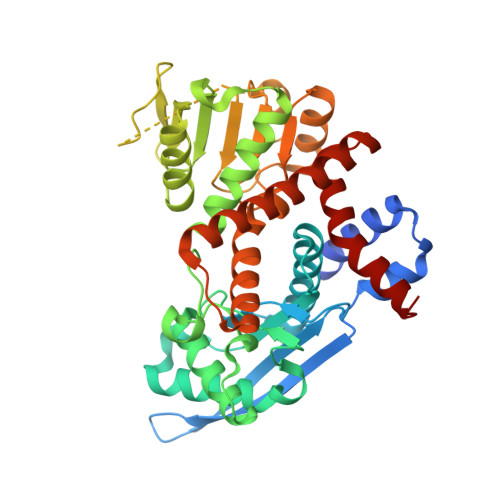Functional dissection of a trigger enzyme: mutations of the bacillus subtilis glutamate dehydrogenase RocG that affect differentially its catalytic activity and regulatory properties
Gunka, K., Newman, J.A., Commichau, F.M., Herzberg, C., Rodrigues, C., Hewitt, L., Lewis, R.J., Stulke, J.(2010) J Mol Biol 400: 815-827
- PubMed: 20630473
- DOI: https://doi.org/10.1016/j.jmb.2010.05.055
- Primary Citation of Related Structures:
3K8Z, 3K92 - PubMed Abstract:
Any signal transduction requires communication between a sensory component and an effector. Some enzymes engage in signal perception and transduction, as well as in catalysis, and these proteins are known as "trigger" enzymes. In this report, we detail the trigger properties of RocG, the glutamate dehydrogenase of Bacillus subtilis. RocG not only deaminates the key metabolite glutamate to form alpha-ketoglutarate but also interacts directly with GltC, a LysR-type transcription factor that regulates glutamate biosynthesis from alpha-ketoglutarate, thus linking the two metabolic pathways. We have isolated mutants of RocG that separate the two functions. Several mutations resulted in permanent inactivation of GltC as long as a source of glutamate was present. These RocG proteins have lost their ability to catabolize glutamate due to a strongly reduced affinity for glutamate. The second class of mutants is exemplified by the replacement of aspartate residue 122 by asparagine. This mutant protein has retained enzymatic activity but has lost the ability to control the activity of GltC. Crystal structures of glutamate dehydrogenases that permit a molecular explanation of the properties of the various mutants are presented. Specifically, we may propose that D122N replacement affects the surface of RocG. Our data provide evidence for a correlation between the enzymatic activity of RocG and its ability to inactivate GltC, and thus give insights into the mechanism that couples the enzymatic activity of a trigger enzyme to its regulatory function.
Organizational Affiliation:
Abteilung für Allgemeine Mikrobiologie, Institut für Mikrobiologie und Genetik, Georg-August-Universität Göttingen, Grisebachstr. 8, D-37077 Göttingen, Germany.














